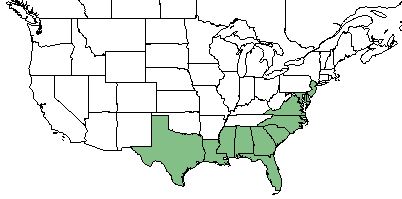Difference between revisions of "Galium hispidulum"
| Line 1: | Line 1: | ||
{{italic title}} | {{italic title}} | ||
| − | Common name: coastal bedstraw | + | Common name: coastal bedstraw |
<!-- Get the taxonomy information from the NRCS Plants database --> | <!-- Get the taxonomy information from the NRCS Plants database --> | ||
{{taxobox | {{taxobox | ||
Revision as of 16:15, 12 June 2018
Common name: coastal bedstraw
| Galium hispidulum | |
|---|---|

| |
| Photo by the Atlas of Florida Plants Database | |
| Scientific classification | |
| Kingdom: | Plantae |
| Division: | Magnoliophyta - Flowering plants |
| Class: | Magnoliopsida - Dicots |
| Order: | Rubiales |
| Family: | Rubiaceae |
| Genus: | Galium |
| Species: | G. hispidulum |
| Binomial name | |
| Galium hispidulum Michx. | |

| |
| Natural range of Galium hispidulum from USDA NRCS Plants Database. | |
Contents
Taxonomic Notes
Synonyms: Galium bermudense L.
Varieties: none
Description
Also known as coastal bedstraw, G. hispidulum is a native perennial forb that is a member of the Rubiaceae family. [1]
Distribution
G. hispidulum is native to the southeast United States, ranging sparsely from east Louisiana and following the coastlines to Maryland and Delaware. [1]
Ecology
Habitat
G. hispidulum grows in maritime forests, dry sandy forests, and sandhills. [2] It is mostly found in well-drained soils along the Gulf coastal plain. [3] While it is present in these natural communities, G. hispidulum is only seen occasionally and not as frequent. [4] It can be found in native cover communities as well as disturbed sites. [5]
Associated species - Salvia lyrata, Elytraria caroliniensis, Dyschoriste humistrata, and Sanicula canadensis. [6]
Phenology
Flowering time for G. hispidulum ranges from April until August, yet also has been recorded flowering in the months of October and December. [7]
Seed dispersal
Seeds of G. hispidulum are primarily dispersed through animal consumption. [5]
Fire ecology
The species has been seen to be associated with a low rate of fire dependence, where the community is not burned as often as other normal sites. [8]
Use by animals
It is a minor source of herbivory for large mammals in its respective communities. [1]
Conservation and Management
This plant is listed as endangered by the states of Maryland and New Jersey and their Department of Environmental Protection. [1]
Cultivation and restoration
Photo Gallery
References and notes
- ↑ 1.0 1.1 1.2 1.3 USDA Plants Database URL: https://plants.usda.gov/core/profile?symbol=GAHI
- ↑ Weakley, A. S. (2015). Flora of the Southern and Mid-Atlantic States. Chapel Hill, NC, University of North Carolina Herbarium.
- ↑ Allen, C. M. (2013). "Notes on the identification and distribution of the species of the genus Galium (Rubiaceae) in Louisiana." Journal of the Botanical Research Institute of Texas 7: 509-513.
- ↑ Rodgers, H. L. and L. Provencher (1999). "Analysis of Longleaf Pine Sandhill Vegetation in Northwest Florida." Castanea 64(2): 138-162.
- ↑ 5.0 5.1 Creech, M. N., et al. (2012). "Alteration and Recovery of Slash Pile Burn Sites in the Restoration of a Fire-Maintained Ecosystem." Restoration Ecology 20(4): 505-516.
- ↑ Hill, N. M., et al. (2000). "Low catchment area lakes: New records for rare coastal plain shrubs and Utricularia species in Nova Scotia." Rhodora 102(912): 518-522.
- ↑ PanFLora URL: http://www.gilnelson.com/PanFlora/
- ↑ Mehlman, D. W. (1992). "Effects of fire on plant community composition of North Florida second growth pineland." Bulletin of the Torrey Botanical Club 119(4): 376-383.